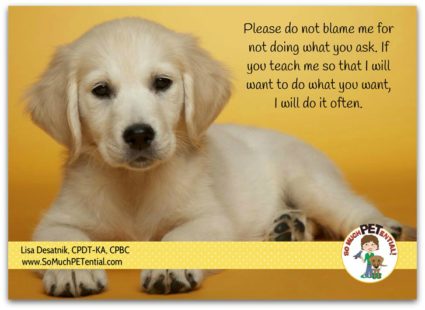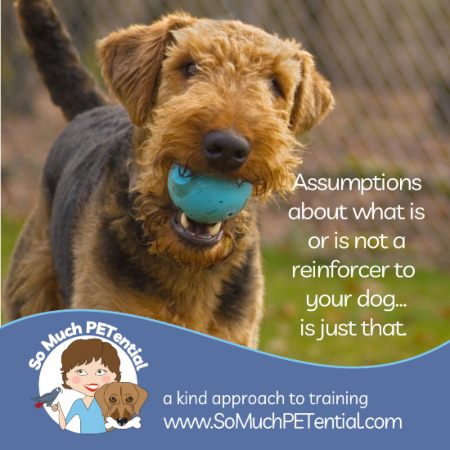I see it happen a lot. People ask their dog to do a behavior (give their dog a cue) and their dog does any number of things EXCEPT the behavior that is asked of it to do.
 Why this happens can be any number of reasons.
Why this happens can be any number of reasons.
Among those reasons:
In your dog training, the cue has been severely weakened by negative consequences occurring after a behavior (as an example, you call your dog to come from play and then lock him in a room by himself or you ask your dog to sit and if he is slow, then you push his rear end to the ground).
The cue was not ‘proofed’ meaning it was not taught in a variety of environments with a variety of criteria, and so what your dog may know in one situation does not generalize to ALL situations.
Doing anything BUT the behavior cued results in a bigger payday than doing the behavior that is cued.
In your dog training, the behavior that was intended to be cued has not been taught with clear criteria and fluency, and thus the cue meaning for the learner is different from the meaning you had intended. As an example, you may want your dog to ‘stay’ in a down position for five minutes until released but your dog gets up in five seconds. One of the many questions you should be asking yourself is, ‘does my dog really understand what I mean when I say stay’? It is easy to forget that dogs do not speak human.
What is a cue anyway?
Scientifically speaking, a cue is simply a stimulus that elicits a behavior. Discrimination is the tendency for learned behavior to occur in one situation but not in other situations. (Learning & Behavior, Paul Chance) Therefore, a change in the environment known as a discriminative stimulus becomes a cue for that behavior to be set into motion.
It is important to remember that it is the consequences of that behavior, positive or negative, that determine the future probability of that behavior occurring. The cue is simply an indicator to the learner that that window of time for that consequence to happen is now.
How do you create strong cues?
These are some general tips.
Knowing this about learning, the way to build huge value for cues is by first teaching the behavior that you want to see with the criteria you are looking for, by giving the behavior huge valued reinforcing consequences.
Since you are teaching an association between a cue and a behavior (and the behavior’s consequence), by teaching the behavior first, not only are you pairing the cue with the behavior that is of the criteria you are looking for, you are also pairing the cue with valued consequences that the learner learned through many repetitions. When is the time to add the cue? Add the cue when you can reliably predict that the wanted behavior is about to happen.
Always remember to teach new lessons in environments where your student can succeed so begin in an area with minimal distractions at a time when your dog will be motivated to give you attention.
After successful repetitions and lessons of your dog doing the behavior following your cue, if your dog does not do the behavior after your giving your cue, be very careful not to reinforce your dog’s unwanted choice. Instead, pause and then cue again. If your dog still does not do the behavior after several tries, that is feedback to you as the teacher that you need to go back a step in teaching the behavior. You can also practice being careful not to reinforce your dog for doing the behavior when he does it without the presence of your cue. This is called teaching stimulus control, meaning you are teaching your dog that he will ONLY get reinforced for doing the behavior when cued DURING active training.
Another note about cues is that they should be short and distinct.
Oh yes, and learning AND teaching should be fun!








